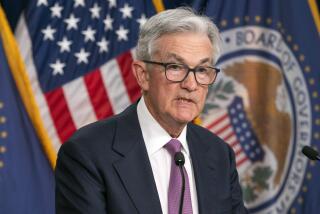Fed official warns unemployment will stay high without more steps
WASHINGTON — A top Federal Reserve official warned that unemployment will remain high through next year unless the central bank takes additional steps to boost the economy.
But John Williams, president of the Federal Reserve Bank of San Francisco, did not directly call for another round of bond-buying, known as quantitative easing, ahead of a meeting next week by the Fed’s policymaking committee.
“I think the argument against further action is the question of uncertainty around the effects, the costs and the benefits of doing so,” Williams said an interview with the Financial Times. Still, he suggested a way to launch another round to get “more bang for the buck.”
His comments reflect the pressure on the Fed to do more to stimulate the lagging recovery, but the need to be cautious in setting market expectations.
Last week, Fed Chairman Ben S. Bernanke told lawmakers that the central bank was ready to take additional steps as recent economic signals have turned sour. But he did not suggest any move was imminent. The Fed’s policymaking Open Market Committee holds its next meeting from July 31 to Aug. 1.
Williams, who is member of the committee, warned of the threats to the U.S. recovery from the European debt crisis, as well as tax increases and spending cuts looming at the start of next year if Congress does not act to prevent the so-called fiscal cliff.
With job creation weak, many lawmakers are pushing the Fed to start another round of bond-buying. The past two rounds of quantitative easing have been controversial because they’ve caused the Fed’s balance sheet to swell.
But with long-term interest rates near zero, bond-buying is the only significant tool left for Fed officials to stimulate growth. Williams said the Fed should consider purchasing mortgage-backed securities rather than Treasury securities if it launches another round of quantitative easing.
“There’s a lot more you can buy without interfering with market function and you maybe get a little more bang for the buck,” Williams told the Financial Times.
He also suggested an open-ended program that did not have a set amount of purchases or a specific end-date would be more effective because the Fed could adjust it to changing conditions.
The last round, known as QE2, involved a set purchase of $600 billion in securities that began in November 2010 and had an end-date of June 30, 2011.
“The main benefit from my point of view is it will get the markets to stop focusing on the terminal date and also focusing on, ‘Oh, are they going to do QE3?’” Williams said. The markets would adjust expectations of Fed purchase based on economic conditions, he said.
ALSO:
Fed chief gives downbeat outlook on economy
California gains jobs, led by trade and tourism
New jobless claims jumped sharply last week to 386,000
More to Read
Inside the business of entertainment
The Wide Shot brings you news, analysis and insights on everything from streaming wars to production — and what it all means for the future.
You may occasionally receive promotional content from the Los Angeles Times.











